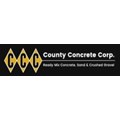
FAQ
Common Questions & Answers
Q. What effect does Water have on concrete.
A. Water can be the most expensive ingredient in our concrete mix. When used in excess it reduces strength, decreases durability, causes cracks and other ailments, which injure the reputation of concrete. Dont ever underestimate the cost of mixing water. In these modern times of increased technology, the water/cement ratio certainly is the water/cash ratio any way you look at it.
Ask our sales or quality control people about Mid-Range Water Reducers and Super Plasticizers.
Q. Concreting in Cold Weather?
A. Winter should be no deterrent to concrete construction. Concrete work of all kinds has been done in extremely cold weather, much to the advantage of labor, contractors and owners. For successful work, however, certain precautions must be observed and understanding of the effects of temperature on new concrete is desirable. Contact our sales or quality control people about Accelerators and other cold weather concreting information and literature.
Q. Why do I run short on my order?
A. Apparent concrete shortages are caused mostly by the following:
1.) Miscalculation of form volume or slab thickness exceeding the assumed thickness by a fraction of an inch. A 1/8th-inch error in a 4-inch slab would mean a shortage of 3% or 1 yard 3 yards in a 32 yard order.
2.) Deflection or distortion of the forms by the pressure of the concrete.
3.) Irregular subgrade, placement over granular fill, and settlement of subgrade prior to placement can increase slab thickness.
Include an allowance of 4%-10% over plan dimensions for waste, over excavations and other causes.
Q. What about hot weather
A. Hot weather Concreting
1.) Concrete mixture designs may include set retarders and water reducers, the lowest possible cement factor.
2.) Adequate manpower to quickly place, finish and cure the concrete.
3.) Limit the addition of water at the job site. In no instance should mote than 2-21/2 gallons per cubic yard be added. Use superplasticizer for additional workability.
4.) Slabs on grade should not be placed on polyethylene sheeting-if a vapor barrier is required, then a bed of damp sand should be placed over it.
5.) Finish as soon as sheen has left the surface; cure immediately for at least 3 days.
6.) Moisten the subgrade, forms and reinforcement prior to placement.
7.) Protect field test cylinders by shading and preventing evaporation. Maintain 600&800 F for cylinders.
Q. What is Curing?
A. Curing is the maintaining of a satisfactory moisture content and temperature in concrete. Curing begins after placement and finishing so that the concrete may develop the desired strength and hardness.
Q. Why Cure?
A. 1.) Predictable strength gain. Laboratory tests show that concrete in a dry environment can lose as much as 50% of its potential strength compared to similar concrete that is moist cured.
2.) Improved durability especially of non-air entrained concrete slabs that may be subject to freezing conditions during construction. Well-cured concrete has better surface hardness and therefore is more watertight.
3.) Better serviceability and appearance